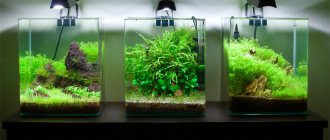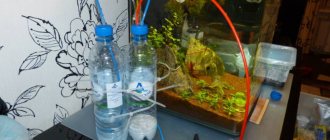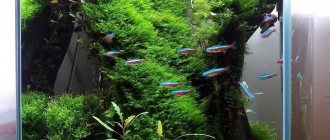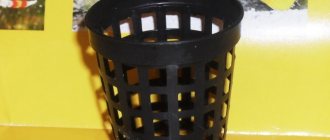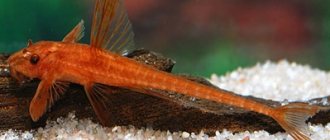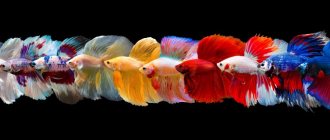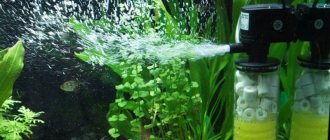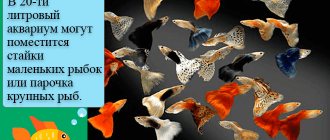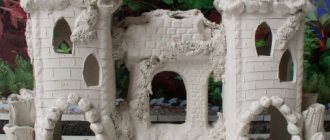A slow herbal aquarium is conventionally called a pond where plants grow much slower than in a forced one. A similar effect can be achieved by reducing to a minimum or completely eliminating the supply of carbon dioxide, installing moderate lighting, limiting the application of fertilizers or even eliminating them if there are enough fish or other inhabitants in the aquarium.
But, of course, for such a reservoir it is necessary to choose the right plants. And an even more important point is the correct start-up, which will ensure the correct operation of the system, requiring minimal intervention.
Why are plants needed in an aquarium?
An aquarium without plants looks “bare” and not so beautiful, but its decorative function is far from the only one. During the life of the inhabitants of the aquarium, nitrates and other harmful substances are formed, which the plants absorb. In addition to absorbing harmful compounds, they are involved in establishing and maintaining biological balance, and in the production of oxygen.
Plants in an aquarium are not only a cleaning filter and a decorative element of an artificial reservoir, they play an important role in the life of its inhabitants. For example, floating and tall plants successfully perform protective functions, serve as a place to hide from aggressive fish, and also as a place to relax.
For herbivorous fish species, tender leaves are natural food, and young fish and fry use plants as shelter from aggressive neighbors.
Some fish use plant leaves to lay eggs or build nests. For example, labyrinth fish prefer floating plants for nesting, and angelfish choose wide leaves for spawning, so plants such as sagittaria or echinodorus are excellent for them.
Illiterate feeding
A sufficient amount of nutrients is the second condition after lighting for the proper development of aquarium vegetation. Partially solving the problem of providing food is a biological substrate, which is purchased at a specialized store.
Vermicompost
Biological substrate
Even vermicompost is suitable for indoor plants. It is poured in a layer of 1 cm, covered with soil on top. The nutrient substrate will ensure high-quality rooting of plants when starting the aquarium.
After a week, you can start fertilizing:
- macro – nitrogen, phosphorus and potassium;
- micro – manganese, iron, calcium, sulfur, magnesium.
Each type is introduced separately. Frequency of feeding - 2 rubles. in Week. If a nutritional support is not used - every day.
What to choose: artificial plants or live ones?
It is quite difficult to give a definite answer here. Live and artificial vegetation in an aquarium have their pros and cons. When making his choice, each aquarist pursues certain goals. Some people strive to create a real living corner at home, while for others the priority is the design component of the aquarium as part of their home or office interior.
Pros of living plants in an aquarium:
Unlike artificial, live aquarium plants absorb carbon dioxide (CO2) well and release oxygen in daylight, absorb toxins, serve as food for fish and shellfish, and suppress the growth of algae in the aquarium. Live plants provide good shelter for fish.
Disadvantages of living plants:
At the same time, the disadvantages of living plants include such factors as:
- ability to cause O2 deficiency at night, provided there are a lot of plants in the aquarium. This problem can usually be corrected by good aeration;
- additional hassle associated with washing and cleaning plants, trimming excess or overgrown bushes, removing dead parts, replanting, applying additional fertilizers, etc.
- availability of good lighting and the cost of purchasing good lamps;
- the cost of planting a large aquarium, without a guarantee that the expensive plant will take root;
- a long wait for small bushes of plants to grow in the aquarium. Until this moment, the reservoir will look poor.
Pros of artificial plants
Regarding artificial plants, we can say that in appearance they are in no way inferior to their natural counterparts, namely in color, beauty, and structural features. Even movement in the water column under the current will look like real plants.
Unlike living ones, they always retain an attractive appearance and will not grow to unacceptable sizes.
If artificial vegetation becomes dirty or covered with algae, it can be easily washed and cleaned, and, if necessary, even treated with a disinfectant to prevent pests and algae.
Another advantage of artificial aquarium plants is that there is no need to create a certain level of lighting using phytolamps, as required by living vegetation.
Among the huge assortment of silk and plastic “grasses” of different sizes and colors, you can easily choose suitable products for your aquarium that will not decompose in water and pollute the artificial pond.
Artificial plants are not afraid of diseases, fish do not eat them, and they do not grow.
In addition, artificial vegetation is a good option for an aquarium containing fish that have the ability to uproot living plants. These include goldfish and cichlids.
Non-living plants will not contribute to the environment like living ones, but they do an excellent job of decorating. You can always change the design depending on your preferences.
Cons of artificial plants
Artificial plants do not absorb CO2. In addition, they do not serve as a source of food for the inhabitants of the aquarium and do not participate in the processing of toxins. Artificial plants will not be able to fully please their aquarist; they will simply be in the aquarium.
Believe me, when you form your home pond, planting it with all kinds of bushes and herbs, take care of them, and they, in turn, give rapid growth, revealing themselves to their owner in all their glory... It’s worth a lot, it’s at this moment that you get real pleasure from aquarium hobby
Shapes and sizes
For beginner aquarists, tanks in the shape of a rectangular parallelepiped are more suitable.
There are also round options, but caring for them requires experience.
It is recommended to take tanks no more than 60 cm high, otherwise it will be difficult to care for the plants.
The standard length of a herbal aquarium is 120-150 cm, and the width is 40-80 cm.
Caring for live aquarium plants
After designing and launching the aquarium, you will need to constantly take care of maintaining cleanliness and comfortable conditions for the inhabitants of the aquatic world. To care for the aquarium, it is enough to spend 15-20 minutes a day and 1-2 hours once a week.
You will also have to additionally solve various problems, for example, if the equipment servicing the aquarium breaks down, buy or repair it.
Daily aquarium care includes:
- feeding the fish;
- assessment of their condition and behavior;
- vegetation inspection;
- checking the operation of lighting, heating, filtration and aeration devices.
Weekly care includes more processes:
- replacing some of the water with fresh water;
- removal of detritus not collected by the filter;
- cleaning the sight glass from plaque and algae;
- plant care.
Unlike artificial ones, live aquarium plants require regular attention and certain knowledge and skills.
Before planting, the plants are cleaned of snail eggs and attached algae, damaged leaves are removed, and disinfected in a pink solution of potassium permanganate. Then the plant is rinsed. The tallest plants are planted in the background. You can read about arranging a home pond in this article.
As a rule, plants are planted in the ground. Pots are used for aquariums containing burrowing fish such as cichlids.
In order for the plant to grow quickly, you need to carefully trim its roots.
When the leaves die, they must be removed immediately, and some long-stemmed plants, such as hygrophila Hygrophilaspp, need pruning, and if there is not enough nitrate added, then aquatic vegetation requires feeding.
Pruning is done not only because of strong growth, but also to form the splendor of the bush.
If the plant has reached the water level, and the stem is bare and looks unattractive, you need to prune it to create side shoots so that the plant becomes attractive. The cut parts can be used as cuttings for planting in other aquariums.
Fertilizers for aquarium plants must be applied carefully, because... their excess is just as dangerous as their deficiency.
Plants, like fish, need water changes; at this point, additional nutrients are added to the aquarium and excess nutrients that they are not able to process are removed.
In order for living plants to look healthy, well-groomed and beautiful, it is necessary to create conditions for their proper development. First of all, care must be taken to create good lighting for photosynthesis, which is an extremely important factor. Then the plants will have a rich, natural color, will not stretch out and have a faded appearance.
If you are not yet ready to care for live plants, you can initially decorate the aquarium space with artificial vegetation, which is simpler and easier to care for. Subsequently, gradually plant the pond, replacing artificial bushes with live ones.
Benefits of setting up a slow herbalist
In addition to the fact that the herbalist is easy to care for, it has another undeniable advantage - low cost of maintenance and upkeep. You practically eliminate the need for aquarium chemicals, and you also won’t spend money on carbon dioxide cylinders.
If you use mosses when decorating, then this is also a good saving on nutritious soil. And you will need low-power lamps, but correctly selected in terms of glow temperature, in order to ensure the slow but healthy development of plants and to avoid the appearance of algae.
It is better to use fluorescent lighting. Daylight hours in a slow herbalist are about 6 hours. With longer illumination (up to 10 hours), hard-leaved plants begin to become covered with an unwanted coating - beard, xinococcus, etc.
Caring for artificial plants in an aquarium
The main condition is timely cleaning. Do not use soap or chemicals for these purposes!
It is best to wash artificial plants not all at once, but one at a time. For these purposes, you can use regular hot water. Plants are left in hot water for 1-15 minutes and then cleaned with a scraper.
Silk plants are thoroughly washed in hot water, then a mixture of lemon juice and ordinary salt is applied with an old toothbrush. The plant is washed again under running water.
A great way to keep artificial plants clean is to keep snails or otocinclus catfish.
Launching fish
Introducing fish into the aquarium.
If the processes in the aquarium are going correctly, after the first week you can start the fish. They buy unpretentious species: guppies, zebrafish. The quantity is no more than a third of the total for the reservoir.
After a few days, the population is brought to half. After another week, the reservoir is completely populated.
Landing is done according to the rules:
- The water in a jar or bag with purchased fish is saturated with oxygen for several hours.
- A little water is drained and added from the aquarium. After 1 hour, repeat aeration.
- They drain and add water all the time so that it becomes like an aquarium. Then all the fish are moved into the pond.
During the first days, water tests are carried out, for which testers will be needed. The level of ammonia, nitrates, acidity is checked.
The food is first frozen or live. It is not advisable to give it dry - it can lead to a bacterial outbreak. If they give it, then little by little, fasting days are arranged.
The water is not changed at first. The need arises if the following fish behavior is observed:
- are constantly at the bottom;
- the upper fin is tucked in;
- gather in schools or swim in pairs.
Conduct rapid testing. If the water temperature is more than +25°C, the acidity exceeds 7.6, change 10-20% of the water.
To restore water balance, the fish are separated for 24 hours. During this time, the amount of ammonia decreases, after which residents are again released into the main reservoir.
Riparium lighting
To provide lighting, it is best to use LED lamps that have the required mounting system. But since this lighting method is quite expensive, they can be replaced with a lamp with T-5 lamps with a mirror reflector.
When you choose a container for your riparium, remember that the growth of flora in it is not limited to the surface of the water. Plants here also grow above the surface of the water, so it should be taken into account that there should be enough free space between the water and the lighting fixtures.
Types of ripariums
Such aquariums are most often equipped in one of two types:
- Open, filled with water like a regular one, with all the lamps located quite high above the surface of the water.
- Tall aquarium covered with a lid. Here the container is filled with water no more than 40% (optimally 30-35%).
Typically, in a riparium the water level is lower than in other types of decorative aquariums.
